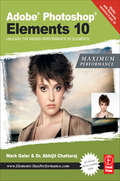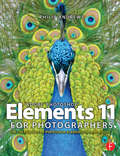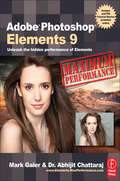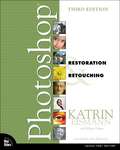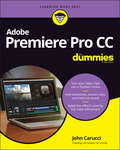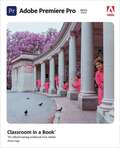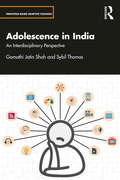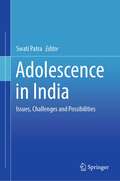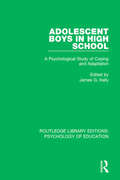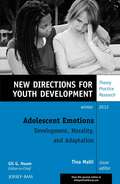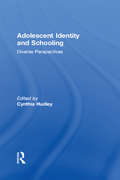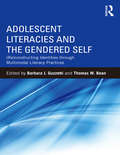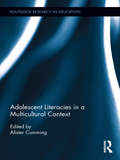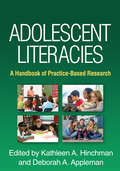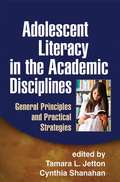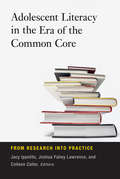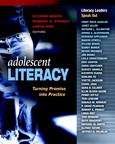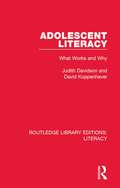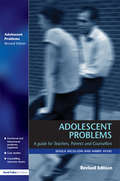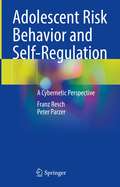- Table View
- List View
Adobe Photoshop Elements 10: Unleash the hidden performance of Elements
by Mark Galer Abhijit ChattarajMaster the most powerful photo editing tools and techniques that Elements has to offer! Using step-by-step projects, Mark Galer will have you creating stunning images in no time at all. Whether you want to create impressive, seamless montages, optimize your photos for perfect print quality, or simply enhance your images for maximum impact, Maximum Performance will give you the skills and know-how you need to create professional quality results. Featured projects teach you how to work with multilayered 16 bit/channel files, as well as convert to black and white using Adobe Camera Raw, create High Key images, work with image borders and textures, and create tilt-shift and cross-process effects. Three movie tutorials featuring specific techniques from the book are available for free online, and a supplemental package of images and movies can be purchased with an easy one-time download from the authors' website, www.elements-maxperformance.com. Find everything you need to unleash the power of Elements with Max Performance, or for a more interactive learning experience, download the supplemental images and movies for comprehensive, hands-on learning.
Adobe Photoshop Elements 11 for Photographers: The Creative Use of Photoshop Elements
by Philip AndrewsTo coincide with some of the biggest changes in Photoshop Elements for years, Philip Andrews completely revises his bestselling title to include all the new features of this release. See how the new interface works alongside new tools, techniques and workflows to make editing, enhancing and sharing your pictures easier than ever. And as always, he introduces the changed and improved features with colorful illustrations and the clear step-by-step instruction that has made his books the go-to titles for photographers the world over. In this edition Andrews highlights the following new features: Interface for both the Editor and Organizer Revel integration in Organizer New tools in the Quick Editor workspace Changes to the Actions palette Pen and Ink, Comic and Graphic Novel filters Vignette, Tilt-Shift, High Key, and Low Key Guided Edit effects Places, People and Events Organizer work modes Changes for Adobe Camera Raw Supercharged folder view Online content The Task bar Exposure and Vibrance sliders in Quick Edit At the same time, Andrews provides a comprehensive overview of the most used tools and techniques in the rest of the program. Readers also benefit from a being able to access book resources and instructional videos at the associated website photoshopelements.net. They can also extend their learning with the special Photoshop Elements for Photographers app available from the Apple App Store.
Adobe Photoshop Elements 8 for Photographers
by Philip AndrewsA complete reference guide for all levels of photographers who use Adobe Photoshop Elements.
Adobe Photoshop Elements 8: Unleash the hidden performance of Elements
by Mark GalerUsing a unique combination of step by step projects, movie tutorials and sample images, Mark Galer guides the reader through the most powerful photo editing tools that Elements has to offer. Discussing and demonstrating the skills and know-how to create professional-quality results with this budget-priced software. Whether optimizing photographs for printing, enhancing images for maximum impact, or creating impressive, seamless montages, this book will enable any aspiring digital professional to get the maximum performance from the credit crunch approved software.The package is completed with astonishingly comprehensive downloadable resources packed with over 7 hours of movie tutorials, 100+ sample images, a stock photo gallery as well as automated actions to get even more out of the software.
Adobe Photoshop Elements 9: Unleash the hidden performance of Elements
by Mark GalerLet Mark Galer guide you through the most powerful photo editing tools and techniques that Elements has to offer! A unique cominbtion of step-by-step projects, movie tutorials and sample images will have you creating stunning images in no time at all. Whether you want to enhance your images for maximum impact, optimize your photos for perfect print quality, or creating impressive, seamless montages, Maximum Performance will give you the skills and know-how to create professional quality results, enabling you get maximum performance from this credit crunch approved software. The package is completed with an astonishingly supportive website packed with over 7 hours of movie tutorials, 100+ sample images, multimedia content and stock photography as well as automated actions to get even more out of the software.
Adobe Photoshop Restoration & Retouching (Third Edition)
by Katrin Eismann Wayne PalmerThe third edition of Photoshop Restoration & Retouching has been reviewed, updated, and revised on every single technique to address the most important features in Adobe Photoshop CS2. This book is divided into three primary areas: Improving tone, contrast, exposure, and color; Removing dust and mold, and repairing damage; and Professional portrait and glamour retouching.
Adobe Premiere Pro CC For Dummies
by CarucciWhen the filming stops, the real video production work begins Ever wonder how your favorite video creators regularly put out such slick content? They're probably using Adobe Premiere Pro CC, a go-to video production app for both professional and amateur video creators. Adobe Premiere Pro CC For Dummies walks you through each step of editing and producing slick and stylish videos that stand up to what the pros post. From transferring your digital movie files from your camera or phone to your computer all the way to uploading your latest creation to YouTube or the web, this book has the info you need to bring your ideas to life. If you're new to video production, you can begin at the beginning with the handbook's user-friendly guide to the basics of setting clips on the timeline and making them flow seamlessly. Or, if you've already got a few videos under your belt, you can skip right to the more advanced material, like special effects and handy tricks of the trade. You’ll also find: Instruction on joining video clips into a continuous final product, complete with transitions, special effects, and more Advice on improving sound, getting rid of color errors, and customizing the look of your videos with filters and aftereffects Straightforward guides to adding voiceovers and soundtracks to your videos So, if you're new to Adobe Premiere Pro CC—or digital video editing in general—Adobe Premiere Pro CC For Dummies is the first and last resource you'll need to start editing like a pro.
Adobe Premiere Pro Classroom In A Book (Classroom In A Book Ser.)
by Maxim JagoThe fastest, easiest, most comprehensive way to learn Adobe Premiere Pro Classroom in a Book®, the best-selling series of hands-on software training workbooks, offers what no other book or training program does―an official training series from Adobe, developed with the support of Adobe product experts. Adobe Premiere Pro Classroom in a Book (2022 release) contains 17 lessons that cover the basics and beyond, providing countless tips and techniques to help you become more productive with the program. You can follow the book from start to finish or choose only those lessons that interest you.
Adolescence in India: An Interdisciplinary Perspective (Principles-based Adaptive Teaching)
by Gomathi Jatin Shah Sybil ThomasAdolescence in India: An Interdisciplinary Perspective highlights the need and importance of studying adolescence in the domain of education. Using an interdisciplinary approach, it discusses adolescence from the perspective of sociology, psychology, education and health studies. Against the backdrop of economic development and globalization, the book looks at adolescence in the changing social milieu. It offers an understanding of adolescence by exploring the socio-cultural influences on adolescents and their interactions in various spaces like the school, among peers, family and the media. The book reflects on classroom group processes and instructional practices for better psychosocial growth of adolescents as well as discusses the need for a greater emphasis on making resources available for adolescents to realise and strengthen their skills and agency. The book outlines various life-skills policies and programmes in India and uses vignettes, anecdotes, emerging classroom discussions, case studies, activities, and self-assessment tools and questionnaires to facilitate a deeper understanding of the concept. The book will be of interest to students, teachers, and educators in teaching programmes including educational psychology, adolescent psychology, and human development. It will also be useful for policymakers, NGOs, and public and private sector bodies who work in the field of adolescent psychology.
Adolescence in India: Issues, Challenges and Possibilities
by Swati PatraThis book provides a comprehensive, in-depth and practical approach towards an understanding of the multitude challenges of adolescence in India. Going beyond the traditional ‘storm, stress and strain’ view of adolescents, it focuses on the strengths of adolescents and highlights a community approach towards an understanding of adolescents. The book is divided into three sections. Section 1 introduces the concept of adolescence in the Indian context, discusses the identity development and peer relations in adolescents. Section 2 deliberates on issues and challenges such as depression, suicide, violence, substance use and behavioural addiction, keeping in mind the Indian socio-cultural context. It also highlights concerns of adolescents related to disabilities. Section 3 provides various prevention and intervention measures including both individual-based and group-based interventions to deal with these challenges, thereby facilitating the journey of adolescents. It helps the reader to focus on the positive development of the adolescents. The book is useful for students in psychology, education, counselling, mental health and development. It is also a great resource book for professionals working in the field of health in general and mental health in particular.
Adolescent Boys in High School: A Psychological Study of Coping and Adaptation (Routledge Library Editions: Psychology of Education)
by James G. KellyOriginally published in 1979, the research reported in this volume is based on investigations of how tenth-grade boys cope and adapt to the high-school environment in, specifically, two high schools in suburban Detroit in 1970. In addition to information about the ways that students relate to the high school environment, this volume presents examples of how multiple research methods can be used to investigate the expression of complex person and environment relationships. This volume has been prepared to illustrate the application of an ecological point of view for research on person-environment relationships. It was hoped that the community psychologist, social psychologist, and school psychologist interested in doing research with adolescents and the high school environment would find the presentation of research methods informative and encouraging. For those readers involved in teaching and administering in secondary education, the volume was an example of how research can illustrate the ongoing personal and social characteristics of students and the high school environment.
Adolescent Development and School Achievement in Urban Communities: Resilience in the Neighborhood
by Patricia A. Jarvis Gary L. CreaseyThis timely volume explores essential themes, issues, and challenges related to adolescents’ lives and learning in underserviced urban areas. Distinguished scholars provide theoretically grounded, multidisciplinary perspectives on contexts and forces that influence adolescent development and achievement. The emphasis is on what is positive and effective, what can make a real difference in the lives and life chances for urban youths, rather than deficits and negative dysfunction. Going beyond solely traditional psychological theories, a strong conceptual framework addressing four domains for understanding adolescent development undergirds the volume: developmental continuities from childhood primary changes (biological, cognitive, social) contexts of development adolescent outcomes. A major federal government initiative is the development of programs to support underserviced urban areas. Directly relevant to this initiative, this volume contributes significantly to gaining a realistic understanding of the contexts and institutions within which urban youths live and learn.
Adolescent Emotions: New Directions for Youth Development, Number 136 (J-B MHS Single Issue Mental Health Services #123)
by Tina MaltiTake an in depth look at how emotions relate to adolescents’ decision making, reasoning, and behavior in morally relevant situations. It provides a summary of current research on emotions, morality, and adaptive behaviors. Furthermore, it discusses new approaches to research on emotions, morality, and socially adaptive behavior in adolescence. By doing so, the articles provide new insights into adolescents’ emotional and moral development and show how emotions contribute to the way adolescents negotiate, resolve, and adapt to the moral and social conflicts that inevitably occur in their everyday lives. By integrating innovative perspectives from developmental, educational, and clinical research, this volume has much to offer for researchers, youth practitioners, and educators. This is the 136th volume of New Directions for Youth Development, the Jossey-Bass quarterly report series dedicated to bringing together everyone concerned with helping young people, including scholars, practitioners, and people from different disciplines and professions.
Adolescent Identity and Schooling: Diverse Perspectives
by Cynthia HudleyAdolescent Identity and Schooling: Diverse Perspectives examines a range of issues related to student adjustment and achievement through research on student identity. Drawn from leading experts in psychology and sociology, it attends to important contemporary topics in educational and developmental psychology. With special attention to how students assess and relate to their own identities, this book features chapters on pertinent but under-represented identities such as parental identity, immigrant identity, and model minority identity. It blends these new topics with chapters containing the most current perspectives on traditionally covered topics, such as race and social class. In ten chapters, this book provides readers with a comprehensive set of perspectives on the relationship between student identity and success in school, making it ideal for education courses on identity in education, educational psychology, and human development.
Adolescent Literacies and the Gendered Self: (Re)constructing Identities through Multimodal Literacy Practices
by Thomas W. Bean Barbara J. GuzzettiToday’s youth live in the interface of the local and the global. Research is documenting how a world youth culture is developing, how global migration is impacting youth, how global capitalism is changing their economic and vocational futures, and how computer-mediated communication with the world is changing the literacy needs and identities of students. This book explores the dynamic range of literacy practices that are reconstructing gender identities in both empowering and disempowering ways and the implications for local literacy classrooms. As gendered identities become less essentialist, are more often created in virtual settings, and are increasingly globalized, literacy educators need to understand these changes in order to effectively educate their students. The volume is organized around three themes: gender influences and identities in literacy and literature; gender influences and identities in new literacies practices; and gender and literacy issues and policies. The contributing authors, from North America, Europe, and Australia offer an international perspective on literacy issues and practices. This volume is an important contribution to understanding the impact of the local and the global on how today’s youth are represented and positioned in literacy practices and polices within the context of 21st century global/cosmopolitan life.
Adolescent Literacies in a Multicultural Context (Routledge Research in Education)
by Alister CummingThis book presents results from a four-year project addressing the central question: What factors, challenges, and contexts contribute to and constrain literacy achievement among at-risk adolescent learners with culturally diverse backgrounds? Researchers consider the importance of several, interrelated factors that support the development of adolescents’ literacies in multilingual contexts: support from educators, community groups, families, and peers; recognition of the multi-faceted complexity of literacy through multiple, complementary methods of research and assessment; approaches to pedagogy that engage learners’ zones of proximal development in humanistic and purposeful ways; and promoting students’ vocabulary knowledge, strategies for reading, writing, and learning, and orientations to engaging with epistemic purposes of literacy critically, through multiple media, and with self-confidence.
Adolescent Literacies: A Handbook of Practice-Based Research
by Kathleen A. Hinchman and Deborah A. ApplemanShowcasing cutting-edge findings on adolescent literacy teaching and learning, this unique handbook is grounded in the realities of students' daily lives. It highlights research methods and instructional approaches that capitalize on adolescents' interests, knowledge, and new literacies. Attention is given to how race, gender, language, and other dimensions of identity--along with curriculum and teaching methods--shape youths' literacy development and engagement. The volume explores innovative ways that educators are using a variety of multimodal texts, from textbooks to graphic novels and digital productions. It reviews a range of pedagogical approaches; key topics include collaborative inquiry, argumentation, close reading, and composition.
Adolescent Literacy in the Academic Disciplines
by Tamara L. JettonFrom leading authorities in both adolescent literacy and content-area teaching, this book addresses the particular challenges of literacy learning in each of the major academic disciplines. Chapters focus on how to help students successfully engage with texts and ideas in English/literature, science, math, history, and arts classrooms. The book shows that while general strategies for reading informational texts are essential, they are not enough-students also need to learn processing strategies that are quite specific to each subject and its typical tasks or problems. Vignettes from exemplary classrooms illustrate research-based ways to build content-area knowledge while targeting essential reading and writing skills.
Adolescent Literacy in the Era of the Common Core: From Research into Practice
by Joshua Fahey Lawrence Jacy Ippolito Colleen ZallerAdolescent Literacy in the Era of the Common Core provides school leaders, teachers, and others with strategies and best practices for advancing adolescent literacy in the classroom. Exceptionally clear and accessible, the book addresses a full range of topics in this vitally important field, including disciplinary literacy; vocabulary instruction; classroom discussion; motivation and engagement related to digital literacy; the use of multiple texts; and writing to learn. This book presents "usable knowledge" of the highest order and of immediate value to school leaders and teachers. It will be required reading for all educators concerned with promoting and furthering adolescent literacy today.
Adolescent Literacy in the Era of the Common Core: From Research into Practice
by Jacy Ippolito, Joshua Fahey Lawrence, and Colleen ZallerAdolescent Literacy in the Era of the Common Core provides school leaders, teachers, and others with strategies and best practices for advancing adolescent literacy in the classroom. Exceptionally clear and accessible, the book addresses a full range of topics in this vitally important field, including disciplinary literacy; vocabulary instruction; classroom discussion; motivation and engagement related to digital literacy; the use of multiple texts; and writing to learn. This book presents &“usable knowledge&” of the highest order and of immediate value to school leaders and teachers. It will be required reading for all educators concerned with promoting and furthering adolescent literacy today.
Adolescent Literacy: Turning Promise Into Practice
by Kylene Beers Robert E. Probst Linda RiefA handbook for middle and high school teachers, school and district administrators, and local, state, and national policy makers, on how to improve literacy instruction in all classes.
Adolescent Literacy: What Works and Why (Routledge Library Editions: Literacy #4)
by Judith Davidson David KoppenhaverOriginally published in 1988. Much has changed since then in schools. Mobile technologies, interactive whiteboards, digital texts, class websites, student-authored blogs, social networking and photo sharing sites found integrated into so many classrooms hadn’t even been imagined by most educators. What hasn’t changed, however, are the developmental needs of adolescents. A sense of competence, opportunities for creative expression, positive social interactions, and opportunities for self-definition remain centrally important. Similarly, print literacy (i.e., reading and writing with traditional orthography) continues to contribute strongly to academic success, employment opportunity, health, and life satisfaction. Consequently, this book remains very relevant today. Through case descriptions of literacy programs situated in formal and informal settings, the book draws attention to the ways that developmental appropriateness and engaging literacy instruction can assist all youth in reaching their full potential as readers and writers.
Adolescent Problems: A Practical Guide For Parents, Teachers And Counsellors
by Harry Ayers Doula NicolsonFirst published in 1997, this book has been updated and revised to bring it in line with new legislation and current concerns. It is an eclectic reference book on adolescent emotional and behavioural problems, covering a range of psychological theories and approaches in a readable style. The theory presented is tied in with practical application using illustrative case studies and there are time-saving interview sheets and other material for teachers/counsellors to use.
Adolescent Reputations and Risk: Developmental Trajectories to Delinquency (Advancing Responsible Adolescent Development)
by Annemaree Carroll John A. Hattie Stephen Houghton Kevin DurkinThe news of teenagers and even younger children committing ever more serious and violent crimes continues to shock and baffle. The escalating psychological and social toll of youth crime is being paid by all - from victims to offenders to parents and siblings to teachers and to the community as a whole. "Adolescent Reputations and Risk" looks beyond traditional theories to examine, from a solid empirical basis, the motivation and values that make some young people choose antisocial over positive behavior, resulting in potent new insights and possible solutions to this ongoing problem. Synthesizing 15 years of research with delinquent youth, this volume describes the volatile dynamic of child and adolescent social worlds, emphasizing reputation enhancement and goal-setting as bases underlying deviant behavior. In innovative and accessible terms, "Adolescent Reputations and Risk" addresses delinquency throughout the course of childhood and adolescence, offers the first detailed explanation of delinquency by integrating goal-setting and reputation enhancement theories, provides evidence analyzing deviant trends in goal-setting and reputation enhancement terms among primary and high school students, answers key questions on topics such as impulsivity, drug and inhalant use, early-childhood psychopathy, links between ADHD and aggression, and the psychology of loners and includes current data on interventions for at-risk youth, including family and school methods, cognitive-behavioral therapy, wilderness and boot camp programs, and interactive multimedia strategies. This volume is an essential resource for clinical child, school, and counseling psychologists; social workers; and allied education and community mental health professionals and practitioners.
Adolescent Risk Behavior and Self-Regulation: A Cybernetic Perspective
by Franz Resch Peter ParzerThis book is based on the idea that increasing juvenile risk behaviours – like substance abuse, nonsuicidal self-injury, and antisocial or suicidal behaviour – allow adolescents to fulfill developmental tasks like identity-formation and regulation of self-worth. Narcissistic self-exploitation, mobility tasks, flexibility and the challenges of new media exert social pressure on parental figures, distracting and putting strain on their mental resources, which in turn changes and even destroys the emotional dialogue with their offspring. If children themselves experience neglect and lack of emotional bonding - resulting in a lack of self-regulating capacities – risk behaviours are the consequence. The book combines different views in the psychological, social and metatheoretical domains. It consists of three parts: developmental problems of young people, diagnosis of risk behaviours in the nosological framework, and presentation of new morbidity with an increase in symptom prevalence. The book also discusses the threat of the acceleration of social processes and the risks of postmodern society.
